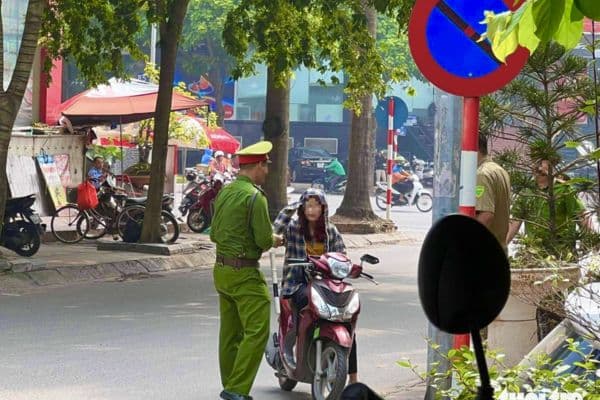In what cases can the commune police stop vehicles for inspection and impose penalties according to Circular 32/2023/TT-BCA?
Under what circumstances can the commune police stop vehicles for inspection and punishment according to Circular 32/2023/TT-BCA?
Based on the provisions at Point c, Clause 2, Article 33 of Circular 32/2023/TT-BCA as follows:
Duties of Traffic Police and other Police forces
...
2. Duties of other Police forces
...
c) In the absence of Traffic Police, the commune police shall conduct patrols, control according to the plan issued by the competent authority, and report the situation, results of patrol, control, and handling of violations to the Traffic Police force.
The commune police shall only patrol, control, and handle violations on communal roads and other roads under the commune’s management. When detecting operators of motorcycles, mopeds, electric bicycles, simple vehicles committing violations such as: not wearing helmets as regulated, carrying more people than allowed, transporting cumbersome goods or exceeding the size limit, stopping or parking vehicles improperly, speeding, weaving, lacking left rearview mirrors, using umbrellas, operating vehicles under the age limit, or detecting serious traffic violations that if not promptly stopped will cause dangerous consequences for society, then they shall handle according to legal regulations. During the process of resolving and handling the aforementioned violations, if other violations are detected, they shall handle according to their authority. If beyond their sanctioning authority, they shall make administrative violation reports and report to the competent authority for a decision on sanctioning administrative violations as per legal regulations.
The signal to stop traffic, conduct control, and handle violations shall follow the provisions at Clause 2, Article 12, Articles 17, 18, 20, 21, 22, 24, 25, 26, 27 of this Circular.
Thus, based on the above regulation, the commune police are allowed to stop motorcycles, mopeds, electric bicycles, and simple vehicles for inspection when detecting operators committing legal violations such as:
- Not wearing helmets as regulated;
- Carrying more people than allowed; transporting cumbersome goods or exceeding the size limit;
- Stopping or parking vehicles improperly; speeding; weaving; lacking left rearview mirrors;
- Using umbrellas;
- Operating vehicles under the age limit;
- Detecting serious traffic violations that if not promptly stopped will cause dangerous consequences for society.
*Note: During the process of resolving and handling the aforementioned violations, if other violations are detected, they shall handle according to their authority. If beyond their sanctioning authority, they shall make administrative violation reports and report to the competent authority for a decision on sanctioning administrative violations as per legal regulations.
The signal to stop traffic, conduct control, and handle violations shall follow the provisions at Clause 2, Article 12, Articles 17, 18, 20, 21, 22, 24, 25, 26, 27 of Circular 32/2023/TT-BCA.
 When can the commune police stop vehicles for inspection and punishment as per Circular 32/2023/TT-BCA? (Image from the internet)
When can the commune police stop vehicles for inspection and punishment as per Circular 32/2023/TT-BCA? (Image from the internet)
Under what circumstances can traffic police stop vehicles?
Pursuant to Clause 1, Article 16 of Circular 32/2023/TT-BCA, there are 04 cases where Traffic Police can stop vehicles while patrolling and controlling traffic according to the plan, including:
- Directly discovering or through technical and professional means detecting and collecting evidence of violations of road traffic laws and other legal violations;
- Executing orders and plans for total control of traffic vehicles to ensure road traffic safety and social order; specialized patrol, control, and violation handling plans to ensure road traffic safety, social order as issued by the competent authority;
- Having a written request from the Head, Deputy Head of the investigation agency; a written request from relevant functional agencies to stop traffic vehicles for control to ensure security, social order, crime prevention and response, disaster prevention, fire and explosion prevention, epidemic prevention, rescue, and other legal violations. The written request must specify the time, route, stopped vehicle for control and handling, and the coordinating force;
- Receiving reports, reflections, recommendations, and denunciations from organizations and individuals on legal violations by people and vehicles participating in road traffic.
How is the traffic police control procedure conducted?
Based on the provisions at Article 18 of Circular 32/2023/TT-BCA, the procedure for traffic police control is carried out in the following steps:
Step 1: Request the vehicle operator to take safety measures and get off the vehicle.
Step 2: Salute as per the People's Police Conduct Regulation (except for cases where it is known that the person has committed a criminal act, caught in the act, or is under a wanted order). When interacting with individuals committing legal violations, the Traffic Police officer must maintain proper posture, etiquette, and appropriate behavior.
Step 3: Inform the vehicle operator and individuals on the vehicle of the reason for control; request the vehicle operator to present relevant documents or information of relevant documents in the electronic identification account.
Step 4: Perform control of the contents in Clause 2, Article 12 of Circular 32/2023/TT-BCA:
- Control relevant documents related to people and vehicles;
- Control the conditions for vehicle participation in traffic;
- Control compliance with legal regulations on road transport safety;
- Control other relevant content as regulated by law.
For vehicles carrying 10 or more passengers, or vehicles with dimensions equivalent to those carrying 10 or more passengers, direct entry into the passenger compartment is required for control and result notification.
Step 5: Conclude the control
The Traffic Police officer reports to the Team Leader on the control results, informs the vehicle operator and individuals on the vehicle of the control results, violations (if any), and handling measures.
*Note:
- When there are grounds to believe that individuals, vehicles, or objects contain concealed evidence, means, or documents used to commit administrative violations, search individuals, vehicles, or objects according to regulations on handling administrative violations.
- In case of detecting signs of crime, proceed according to the provisions of criminal procedure law.
LawNet